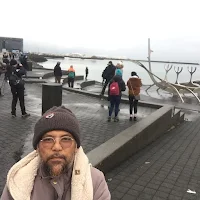Aku selamat sampai di Keflavic Airport Iceland awal
pagi. Lepas tu terus pergi Budget car
rental, dapatlah kereta Hyundai 110.
Angin punyalah kuat dan sejuk pula, ditambah cuaca gelap walaupun baru pukul 8 pagi.
Drive slow-slow dan akhirnya sampai ke Revlik, ibu
kota Iceland. Kecik dan simple aje
bandar ini. So pusing-pusing dan selfie
di tepi laut, tempat pelancong perpusu-pusu untuk ambil gambar dekat replica perahu
Viking.
Dah tengahari, aku pergi cari masjid dulu sebab check
in hostel jam 3 petang. Banyak masa
lagi. Nak cari makanan halal memanglah
payah. Beli roti perancis aja, serunding daging, maggi dan kopi Hang Tuah ada
bawak dari Malaysia.
Akhirnya aku sampai juga kat masjid di bandar ini
tapi macam dalam bangunan kedai aje, dan ada tertulis Félag
múslima á Íslandi
Lepas tu
aku study sikit tentang sejarah Islam di Iceland ini.
Islam in Iceland is
a minority religion. The Pew Research Center estimated that roughly
0.2% of the country was Muslim in 2010. (740 people).
The
earliest mention of Iceland in Muslim sources originates in the works
of Muhammad al-Idrisi (1099–1165/66)
in his famous Tabula Rogeriana,
which mentions Iceland's location in the North Sea.
The
long-distance trading and raiding networks of the Vikings will have meant that various
Icelanders, like the Norwegians Rögnvald Kali
Kolsson or Harald Hardrada, came into direct contact
with the Muslim world during the Middle Ages; indirect connections are
best attested by finds of Arabic coins in Iceland, as also widely in the Viking
world.
Perhaps
the earliest known example of Muslims coming to Iceland occurred in 1627, when
the Dutch Muslim Jan Janszoon and his Barbary pirates raided portions of
Iceland, including the southwest coast, Vestmannaeyjar, and the eastern fjords. This
event is known in Icelandic history as the Tyrkjaránið (the
"Turkish Abductions").
An estimated 400-800 Icelanders were sold into slavery.
Islam
started to gain presence in Icelandic culture around the 1970s, partly through
immigration from the Islamic world (for example Salmann Tamimi) and partly through
Icelanders' exposure to Islamic culture while travelling (for example Ibrahim
Sverrir Agnarsson). Some of the immigrants simply came of their own
accord; others came as refugees, including groups from Kosovo. The Koran was
first translated into Icelandic in 1993, with a corrected edition in 2003.
Salmann Tamimi estimates that when he
came to Iceland in 1971 there were perhaps seven Muslims living there. As
of 2013, however,
·
"Muslim Association of
Iceland" (Félag múslima á Íslandi) has 465 members.
·
"The Islamic Cultural Centre of
Iceland" (Menningarsetur múslima á Íslandi) has 305 members.
The
first generation of Muslims born in Iceland probably began with people like
Salmann's own children, such as Yousef Ingi Tamimi (b. 1988). Iceland's
Muslim population is of diverse origins, including people born in the Arab world,
Albania, Africa, and Iceland.
Muslim Association of Iceland
The Muslim Association of Iceland (Félag
múslima á Íslandi) was founded in 1997 by Salmann Tamimi, a Palestinian immigrant; it
was officially recognised on February 25. Since
2010 the chair has been Ibrahim
Sverrir Agnarsson. As of 2014, the association has 465 members.
More than half were born in Iceland; perhaps 40-50 were born to non-Muslim
parents.
The
Muslim Association of Iceland currently runs the Reykjavík Mosque,
a Sunni mosque on the third floor of an
office building in Ármúli 38, Reykjavík. It has two imams and
offers daily and nightly prayers attended by a mix of local Icelanders and
visiting Muslims. It also offers weekly Friday prayers for Jumu'ah. Prayers
are said in Arabic, but English and Icelandic are also widely used due to the
diverse nature of the congregation. The Association regularly runs courses in
both Arabic and Icelandic.








Comments